|
Saturday, March 4, 2006
Hello from the Canadian Rockies: First Impressions
of Calgary
As so many times before, I used my Airmiles
to book our flights to Calgary (with the Westjet Airmiles Mastercard
you get to fly out west for only 1600 Airmiles instead of having
to use 3000 Airmiles in high season with other airlines). As an
astute traveller you have to look at every option of cutting your
travel costs and Airmiles is one of my favourite tools. A direct
flight took us from Toronto to Calgary in about three and a half
hours.
We arrived at the Calgary Airport at roughly 11:25 am and the weather
was rather overcast on arrival with an outside temperature of -12
degrees Celsius. Because we only had about a day in Calgary, an
official tour of the city was going to really give us the lay of
the land and Jocelyne Morrison from Time
Out For Touring was there to pick us up. Jocelyne herself hails
actually from Quebec, but has been living in Calgary for the last
10 years. And it turns out she loves the city and is an absolute
expert in it.
The first thing that struck me upon arrival were all the statues
and sculptures located at the baggage carousels, all with different
themes. Obviously Calgary likes to entertain its visitors while
they wait for their luggage at the airport. The next sight that
caught my attention was a volunteer dressed up in a bright red vest
and cowboy hat who was there to welcome tourists. Jocelyne explained
that Calgary actually is a city of volunteers: 7 out of 10 Calgarians
volunteer their time for a good cause, and volunteers were some
of the main reasons why the Calgary Olympic Games in 1988 were the
first Olympic Games in history to actually make (rather than lose)
money.
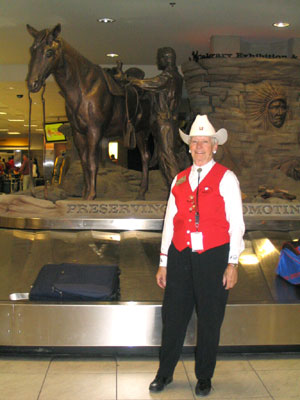
Volunteer at the Calgary Airport
Jocelyne packed us into the touring van and off we went on our
very compact exploration of Calgary. The first thing that struck
me about Calgary was its topography: it is located in a relatively
flat area with a number of long, stretched out low-lying hills.
On good days you can actually see the Rocky Mountains to the west,
but unfortunately the weather was overcast, so we didn't get to
see the Rockies today.
Calgary is divided north-south by the Bow River, and Centre Street
divides the city's east from the west. As a result the city has
4 quadrants with streets running north-south and avenues running
east-west. So in order to find an address you always have to know
whether it is in the northwest, northeast, southwest or southeast
quadrant in Calgary. Jocelyne explained that many of the streets
in Calgary are named after native names, eg. Deerfoot Avenue (apparently
named after a native person who was a really fast runner).
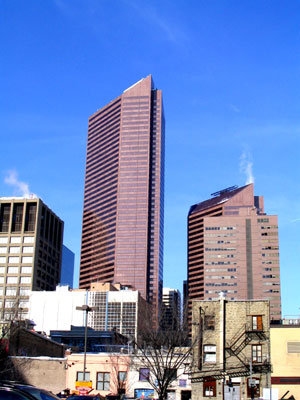
The Petrocanada Towers in downtown Calgary
Nose Hill is one of the most prominent hills in Calgary; it is
a long-stretched out topographical feature without much vegetation.
Jocelyne explained that this type of landscape is pretty much typical
of Calgary as a prairie city. Much of Calgary's natural landscape
is a mix between grassland and semi-arid forests. When it gets very
dry in the summer, there are a lot of grass fires.
Calgary is also a booming city. Cranes are everywhere, and new
subdivisions are growing out of the ground like mushrooms. Essentially
only the downtown area has highrise buildings, while the residential
areas outside of the core mostly consist of single-family homes
rather than highrise apartments. Calgary, as the “Energy Capital
of Canada” and the centre of Canada's oil industry, is experiencing
rapid economic growth and people from all over Canada are migrating
here. The population today is roughly 1 million.
Next we drove by McMahon Stadium, where Calgary’s Stampeders
football team is headquartered. This stadium was also used for the
opening and closing ceremonies during the 1988 Olympic Games, another
reason why Calgary made money on these games: by reusing and refunctioning
existing facilities. Prudent financial management at work......
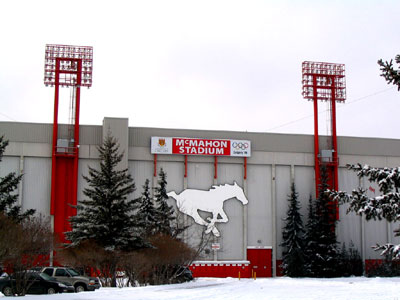
McMahon Stadium
The next big item on the itinerary was "C.O.P.": Canada
Olympic Park, a place so interesting it deserves
its own story. After our guided tour through the Olympic facilities
we drove on the Sarcee Trail to get into downtown Calgary. Coming
into town from the west side we had a very nice view of the cluster
of skyscrapers downtown. While driving in through the residential
areas, Jocelyne explained that a large number of residential condominium
developments are going up downtown. One example of the population
explosion was the move of Canadian Pacific’s headquarters
from Montreal to Calgary in 1996 when 700 families moved into town
at the same time.
Calgary pays a lot of attention to the quality of life of its residents.
The city has hundreds of kilometers of walkways and trails, particularly
beside the Elbow and Bow Rivers. Doglovers in particular have it
good here since the city provides many off-leash areas to its dog-owners.
55 golf courses are located in the immediate vicinity of Calgary
and golf is a very popular pastime here.
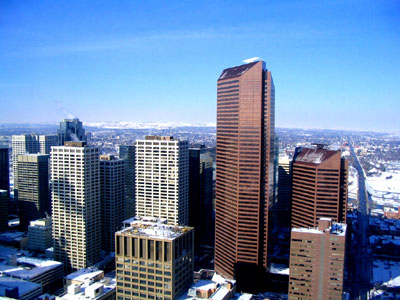
View from the Calgary Tower
We entered the downtown core and Jocelyne pointed out the Gulf
Canada and Canadian Pacific headhquarters. The last steam locomotive
used by the CP Rail is on display outside the CP office tower. The
two skyscrapers of Bankers Hall dominate the skyline, one with a
silver roof, the other with a golden one. We went up the Calgary
Tower, built between 1967 and 1968 originally as the “Husky
Tower”. It holds a revolving restaurant and today it was officially
closed for a private function, but we had a chance to catch an elevated
view of the city.
Just last year the Calgary Tower added a glass-bottomed viewing
area. Jocelyne mentioned that for a special occasion a horse was
brought up for a photo op, but the horse would resist any efforts
of being coaxed onto the glass-bottomed area. I can only understand
that too well because when I was standing there looking straight
down, it made me feel very squeamish too.
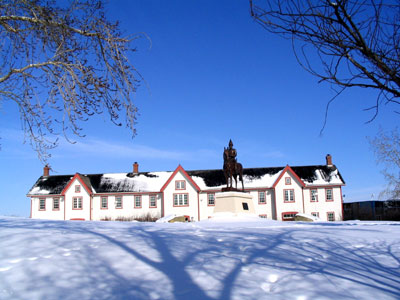
The Barracks at Fort Calgary
Our driving tour continued towards Fort Calgary, Calgary’s
oldest landmark. Fort Calgary was founded in 1875 as a North West
Mounted Police Outpost and today it houses an interpretive centre
and a museum. Jocelyne explained that the exploration of the west
progressed differently here than in the United States in that relations
with the native tribes were relatively peaceful. Prime Minister
John A. MacDonald founded the North West Mounted Police, which later
on became the Royal Canadian Mounted Police. The police arrived
in the west before the settlers and established relations with the
natives.
The Inglewood neighbourhood is located adjacent to Fort Calgary
at the confluence of the Elbow and the Bow Rivers. It’s an
attractive neighbourhood with old trees and established homes and
surrounds a nice commercial street with many restaurants and antique
shops. Jocelyne then took us into a residential neighbourhood called
“Scotsman Hill” which offers a tremendous vista of the
Calgary Saddle Dome and the Stampede grounds, set against the backdrop
of the downtown skyline. A wonderful view…
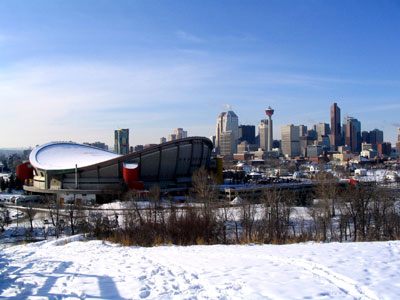
Saddledome with downtown Calgary Skyline, viewed from Scotsman Hill
She then took us past the grounds of the "Calgary Stampede",
Calgary's most famous event. What origjnally started as an agricultural
fair has evolved in a yearly 10-day citywide celebration of western
hospitality and traditions and includes chuckwagon races, rodeos,
rides and a Grandstand Show extravaganza. This year's Stampede will
take place from July 7 to 16, 2006.
Back downtown Jocelyne took us through a former industrial area
called “Eau Claire” which has been converted into one
of Calgary’s most popular downtown residential districts.
On our drive through downtown Jocelyne pointed out a typical Calgarian
feature: the “+15s”: elevated walkways connecting highrise
towers so people can walk between commercial buildings sheltered
from the elements. These "+15" walkways connect various
shopping areas and malls and allow you to explore Calgary's downtown
core without ever setting foot outside.
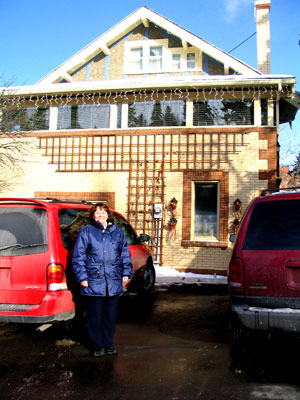
Our expert guide, Jocelyne
The name came about because these walkways had to be at least 15
feet above the street below. Calgary is build on bedrock, and contrary
to Toronto or Montreal which both have a vast network of underground
walkways, Calgary has chosen to provide weather shelter through
elevated walkways.
From there we crossed the Elbow River and entered the Kensington
neighbourhood, one of Calgary’s primary restaurant and shopping
areas. Our guide pointed out a store owned by famous Belgian chocolatier
Bernard Callebeaut who makes sweet local delicacies. I heard some
people say that these are the "best chocolates in the world"....
The next area on our menu was the Uptown 17th Avenue neighbourhood,
another area packed with restaurants and shops. Last but not least,
after taking us on 4th Street, which also houses lots of eateries
and funky stories, Jocelyne took us all the way to our bed and breakfast,
the historic Twin Gables B&B,
where we got to settle in after our sneak peek at Calgary.
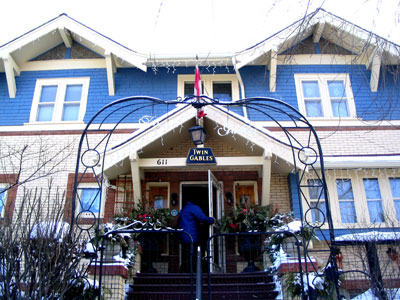
Arrival at the Twin Gables B&B
It was a whirlwind 4 hour tour through town and by the end of it
my head was spinning with all the information. But Jocelyne did
a phenomenal job of acquainting us with her chosen hometown and
it was a perfect introduction to Calgary - "The Heart of the
New West".
Related Articles:
An overview of our discovery of the
Canadian Rockies
Arrival in Calgary and our
whirlwind tour of the city
Discovering Canada Olympic Park,
one of Calgary's most visited attractions
Our fabulous dinner at Il Giardino's
and a connection with one of Calgary's most successful entrepreneurs
- an Italian-Canadian immigrant success story
Comfort, luxury and our celebrity
breakfast at the Historic Twin Gables B&B
Calgary's Kensington area and a
meeting with a local entrepeneur who went from Vietnamese boat person
to successful restauranteur
Arrival in Banff & exploring
a local landmark: the Fairmont Banff Springs Hotel
Our first skiing experience: perfectly
groomed trails at Norquay
High altitude skiing on the
Continental Divide: Sunshine Village
Exploring Canadian history: the
Fairmont Chateau Lake Louise
Skiing in the largest ski resort in
the Canadian Rockies at Lake Louise
A real adventure: dogsledding in
the Canadian Rockies
A gondola trip to the top of
Sulphur Mountain and discoveries of Banff
Our final walk through downtown
Calgary - discoveries of downtown
An interview with Tourism Calgary:
what to see and do in Calgary
An interview with
Tourism Banff Lake Louise
Useful Websites:
Tourism
Calgary
Tourism
Banff Lake Louise
Canada
Olympic Park
Ski the Big 3:
Banff, Lake Louise and Sunshine
Banff
National Park of Canada
Useful books about Calgary and the Canadian Rockies:
|